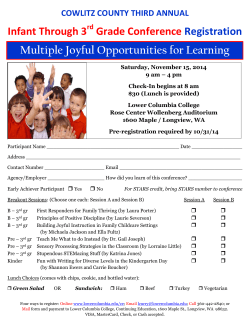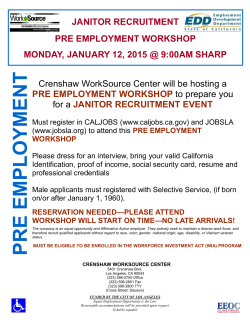
PRE-COLONIAL PERIOD: Philippine History
a look into our past settings, customs, practices and culture Introduction: Pre - History The cultural achievements of pre-colonial Philippines include those covered by prehistory and early history of the Philippines archipelago and its inhabitants, which are the indigenous forebears of today's Filipino people. These early Filipinos possessed a culture and technology that were quite advanced considering the timeline of history of science when it flourished. Waves of migrants who came to settle in the islands contributed to the development of ancient Philippine civilization. Prehistoric aborigines, a cross of Afro-Asiatic and AustroAborigines, now called Negritos (Aeta, Agta, Ayta) reached the islands by way of land bridges around 15,000 to 30,000 BC, and they were excellent hunters and food gatherers. In its midst, other ancient civilizations were also thriving and evolving. The Proto-Malays, a Mongol-Asiatic race, arrived around 2500 BC using oceanic vessels called balangays, and they brought with them their knowledge in seafaring, farming, building of houses from trees and creation of fire for cooking. The next to arrive were the Duetero-Malays, of India-Asiatic race (Indian, Chinese, Siamese, Arabic), that prevailed with a more superior and advanced culture. They possessed their own systems of writing, knowledge and skills in agriculture, metallurgy, jewelry-making as well as boat-building. When the Spaniards came to the islands in the 15th century, industries such as mining, agriculture, fishing and pottery were already in place and contacts with other Asian nations had been long established. Peopling of the Pre-Colonnial Philippines The Negritos were early settlers but their appearance in the Philippines has not been reliably dated ; and they were followed by speakers of the Malayo-Polynesian languages, a branch of the Austronesian languages, who began to arrive in successive waves beginning about 4000 B.C.E, displacing the earlier arrivals. By 1000 B.C. the inhabitants of the Philippine archipelago had developed into four distinct kinds of peoples: tribal groups, such as the Aetas, Hanunoo, Ilongots and the Mangyan who depended on huntergathering and were concentrated in forests; warrior societies, such as the Isneg and Kalingas who practiced social ranking and ritualized warfare and roamed the plains; the petty plutocracy of the Ifugao Cordillera Highlanders, who occupied the mountain ranges of Luzon; and the harbor principalities of the estuarine civilizations that grew along rivers and seashores while participating in trans-island maritime trade. Pre – Colonial Culture During the early period thousand years ago, the early Filipinos were composed of different groups that came from different part of Asia. With different groups they form their own community, system of education and religious belief. They group into different communities composed of 50 to 2,000 individuals and they construct their shelters in different areas according to their lifestyle and source of living. Usually they were situated along the seashores, streams, rivers, forests, fertile land areas and even in caves. In water areas they look for fish, shells and pearls as their source of living. They also used boat and craft as there means of transportation for an easier travel and carrying their goods for trade from one place to another. For those people located in land areas they cultivate the land and plant rice, bananas and crops. After the harvest they no longer use the area indeed they just move to another place with less grass and fine soil and abundant of trees where they can start farming again. Perhaps this gives an idea that the Philippines is very rich of resources for a bountiful living. Pre – Colonial Culture During the pre-colonial time there was already an indigenous spiritual traditions practiced by the people in the Philippines. Generally, for lack of better terminology prehistoric people are described to be animistic. Their practice was a collection of beliefs and cultural mores anchored in the idea that the world is inhabited by spirits and supernatural entities, both good and bad, and that respect be accorded to them through nature worship thus; they believed that their daily lives has a connection of such beliefs. Pre – Colonial Culture These spirits are said to be the anito or diwata that they believed to be good and bad. The good spirits were considered as there relatives and the bad were believed to be their enemies. Some worship specific deities like Bathala a supreme god for the Tagalog, Laon or Abba for the Visayan, Ikasi of Zambal, Gugurang for the people of Bicol and Kabunian of Ilocano and Ifugao. Aside from those supreme deities they also worship other gods like Idialao as god of farming, Lalaon of harvest, Balangay god of rainbow and Sidapa god of death. Pre – Colonial Culture Others also worship the moon, stars, caves, mountains, rivers, plants and trees. Some creatures are being worship too like the bird, crow, tortoise, crocodile and other things they believed has value and connected to their lives. The variation of animistic practices occurs in different ethnic groups. Magic, chants and prayers are often key features. Its practitioners were highly respected (and some feared) in the community, as they were healers, midwife (hilot), shamans, witches and warlocks (mangkukulam), babaylans, tribal historians and wizened elders that provided the spiritual and traditional life of the community. In the Visayas region there is a belief of witchcraft (kulam) and mythical creatures like aswang, Nuno sa Punso and other mythical creature. Pre – Colonial Clothing During this pre-colonial era historians have found out that the “Barong Tagalog” (dress of the Tagalog) already existed. The earliest Baro or Baro ng Tagalog was worn by the natives of Ma-I (the Philippines name before) just before they were colonized by the Spaniards. The men wore a sleeve-doublet made of Canga (rough cotton) that reached slightly below the waist. It is collarless with a front opening. Their loins were covered with a pane that hung between the legs and midthigh. The women also wore a sleeve dress but shorter than the men. They also wear a pane attached to the waist and reaching to the feet accented by a colourful belt. The materials used for their dress is of fine line or Indian Muslin. Pre – Colonial Clothing The Visayan men wore a jacket with a Moorish style rob, that reach down their feet and was embroidered in beautiful colours. Tagalog and Visayan men bound their temples and forehead with a “putong” (a narrow strips of clothe). They also wore gold jewellery and other accessories to beautify their bodies. Pre – Colonial Writing Systems During the early period almost everyone in the society-male or female knows how to read and write. They have their own method of writing which they use sharppointed tools, leaves, bamboo and trunk’s skin. They write from top to bottom and read it from left to right. Accordingly they have their Alibata which script is different from China, Japan and India. This account was told by one of the first Spanish missionaries who came in the Philippines, Fr. Pedro Chirino. Pre – Colonial Writing Systems Another account proved after the discovery of a jar in Calatagan, Batangas. This system of writing came from the alphabet of Sumatra. The first Visayan, Tagalog, Ilocano and some ethic groups have their own dialect and form of writing too. They have an alphabet composed of 17 letters; 3 of which are vowels and 14 are consonants. The Muslims have also their own system basing on there dialect. This is called kirim of Maranao and jiwi of the Tausug, which they are still using until this day. Abugida: Pre – Colonial method of Handwriting (Baybayin) Pre – Colonial Form of Government Before the Spaniards came into the Philippines there were existing culture of the Filipinos which were not distinguished by most of the filipinos especially for the new born filipino citizens. The Filipinos lived in settlements called barangays before the colonization of the Philippines by the Spaniards. As the unit of government, a barangay consisted from 30 to 100 families. It was headed by a datu and was independent from the other group. Pre – Colonial Form of Government Usually, several barangays settled near each other to help one another in case of war or any emergency. The position of datu was passed on by the holder of the position to the eldest son or, if none, the eldest daughter. However, later, any member of the barangay could be chieftain, based on his talent and ability. He had the usual responsibilities of leading and protecting the members of his barangay. In turn, they had to pay tribute to the datu, help him till the land, and help him fight for the barangay in case of war. In the old days, a datu had a council of elders to advise him, especially whenever he wanted a law to be enacted. The law was written and announced to the whole barangay by a town crier, called the umalohokan. Pre – Colonial Houses: Social Classes Before the coming of Spanish colonizers, the people of the Philippine archipelago had already attained a semicommunal and semislave social system in many parts and also a feudal system in certain parts, especially in Mindanao and Sulu, where such a feudal faith as Islam had already taken roots. The Aetas had the lowest form of social organization, which was primitive communal. Social Classes The barangay was the typical community in the whole archipelago. It was the basic political and economic unit independent of similar others. Each embraced a few hundreds of people and a small territory. Each was headed by a chieftain called the rajah or datu. Social Classes The social structure comprised a petty nobility, the ruling class which had started to accumulate land that it owned privately or administered in the name of the clan or community; an intermediate class of freemen called the maharlikas who had enough land for their livelihood or who rendered special service to the rulers and who did not have to work in the fields; and the ruled classes that included the timawas, the serfs who shared the crops with the petty nobility, and also the slaves and semislaves who worked without having any definite share in the harvest. There were two kinds of slaves then: those who had their own quarters, the aliping namamahay, and those who lived in their master's house, the aliping sagigilid. One acquired the status of a serf or a slave by inheritance, failure to pay debts and tribute, commission of crimes and captivity in wars between barangays.
© Copyright 2025













